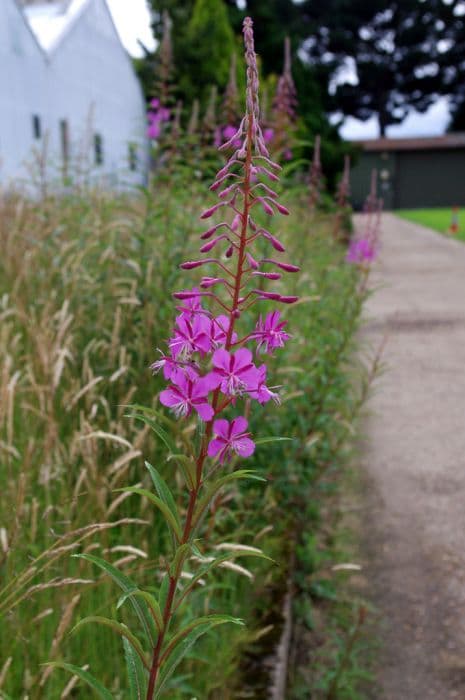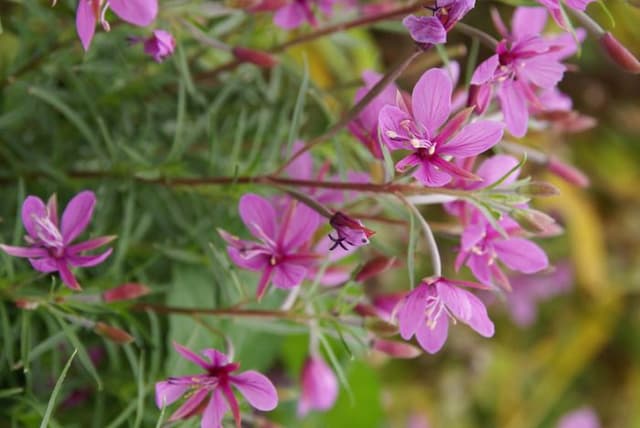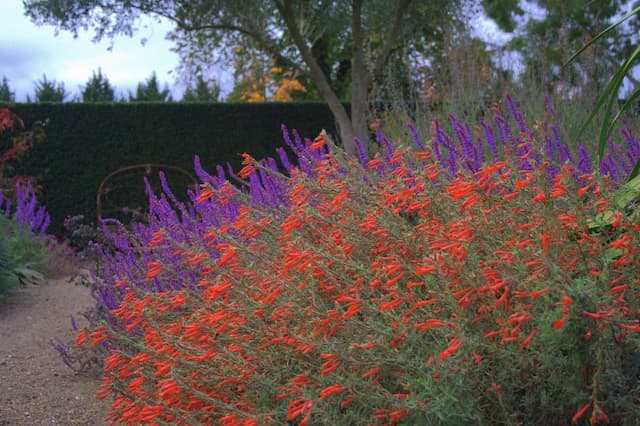Farewell to Spring Clarkia amoena

ABOUT
Clarkia amoena, commonly known as farewell-to-spring, is a captivating flowering plant that is renowned for its showy and colorful blooms. The plant produces elongated stalks that bear an abundance of flowers. The individual flowers are comprised of four broad petals that can exhibit a range of hues including pink, lavender, white, and occasionally with splotches of darker color that add a striking contrast. The center of each blossom typically has a set of contrasting stamens that stand out against the petals. Farewell-to-spring’s leaves are generally narrow and lance-shaped, with a bright green color that serves as a fresh backdrop to the vivid flowers. The overall form of farewell-to-spring is upright and slender, with the foliage and flowers densely arranged along the stems, creating a lush and fluffy appearance during its blooming season. The visual appeal of farewell-to-spring makes it a popular choice for ornamental gardening, adding a splash of late spring to early summer color to landscapes.
About this plant
 Names
NamesFamily
Onagraceae
Synonyms
Farewell-To-Spring, Godetia, Satin Flower
Common names
Godetia amoena, Godetia whitneyi, Godetia grandiflora.
 Toxicity
ToxicityTo humans
Farewell-to-spring is generally not known to be toxic to humans. However, as with any plant material, sensitivity varies from person to person, and it may cause mild stomach upset if ingested in large quantities due to plant cell fibers and natural chemicals that could be irritants.
To pets
Farewell-to-spring is not typically known for being toxic to pets. However, individual animals may have different levels of sensitivity, and eating large amounts might result in gastrointestinal discomfort or an upset stomach. It's always prudent to prevent pets from consuming plants, as reactions can be unpredictable.
 Characteristics
CharacteristicsLife cycle
Annuals
Foliage type
Deciduous
Color of leaves
Green
Flower color
Varies
Height
1-3 feet (0.3-0.9 meters)
Spread
1 foot (0.3 meters)
Plant type
Herb
Hardiness zones
3
Native area
North America
Benefits
 General Benefits
General Benefits- Aesthetic Appeal: Clarkia amoena, also known as Farewell-to-Spring, offers vibrant and colorful blooms that enhance the visual appeal of gardens and landscapes.
- Attracts Pollinators: Its flowers attract bees, butterflies, and other beneficial insects, promoting biodiversity and a healthy ecosystem.
- Easy to Grow: Farewell-to-Spring is recognized for being hardy and easy to cultivate, making it an excellent choice for novice gardeners.
- Drought Tolerance: Once established, it is relatively drought-tolerant, requiring minimal water and adapting well to dry conditions.
- Self-Seeding: This plant often reseeds itself, providing a natural way to propagate and maintain the garden's beauty year after year.
- Erosion Control: Farewell-to-Spring can be used to prevent soil erosion in sloped areas due to its root system and ground-covering growth habit.
 Medical Properties
Medical Properties- This plant is not used for medical purposes.
 Air-purifying Qualities
Air-purifying QualitiesThis plant is not specifically known for air purifying qualities.
 Other Uses
Other Uses- Clarkia amoena, commonly known as farewell-to-spring, has been used in the dyeing process, where its pigments have been applied in traditional textile coloring.
- The fine seeds of farewell-to-spring can be mixed with other small seeds to improve the evenness of spread when seeding expanses of land for restoration projects.
- In floriculture, farewell-to-spring is used for its vibrant colors and long vase life, making it a popular choice for cut flower arrangements and bouquets.
- The plant is considered a model organism in ecological research, helping scientists understand pollination syndromes and plant-insect interactions.
- Gardeners often use the farewell-to-spring to create a ‘living mulch’ that helps retain soil moisture and suppress weed growth.
- The fibers from the stem of farewell-to-spring can be used in the crafting of small eco-friendly items, such as paper or packaging materials.
- In artistic applications, farewell-to-spring has been used for its shape and color to press into bookmarks, greeting cards, or other botanical art projects.
- Landscape designers use farewell-to-spring for wildflower meadows and prairie restorations due to its attractive appearance and ability to attract pollinators.
- Farewell-to-spring seeds may serve as a food source for small birds and insects, playing a role in garden and ecosystem biodiversity.
- The plant has been utilized in educational settings, allowing students to observe and study the stages of plant growth and development.
Interesting Facts
 Feng Shui
Feng ShuiClarkia is not used in Feng Shui practice.
 Zodiac Sign Compitability
Zodiac Sign CompitabilityClarkia is not used in astrology practice.
 Plant Symbolism
Plant Symbolism- Remembrance: Clarkia amoena, commonly known as Farewell-to-Spring, symbolizes remembrance. The name itself suggests a nostalgic reflection on the passing of the spring season.
- Ephemeral Beauty: Farewell-to-Spring suggests the fleeting nature of beauty as it blooms in late spring to early summer, marking the transition to warmer seasons and reminding us of the impermanence of life's beautiful moments.
- Adoration: This plant is often associated with adoration due to its bright and delicate flowers, representing the loving and heartfelt adoration one may have for another.
 Water
WaterFarewell to Spring, commonly known as Godetia, prefers even moisture and should be watered regularly, especially during dry spells. An inch of water per week is sufficient, either from rainfall or manual watering. During hot weather, more frequent watering may be necessary to keep the soil evenly moist but not waterlogged. It is best to water the plant at the base to avoid wetting the foliage, which can lead to fungal diseases. Allow the soil to dry out slightly between waterings.
 Light
LightFarewell to Spring thrives in full sun conditions, meaning it should receive at least six hours of direct sunlight daily. A spot that gets bright, unfiltered sunlight will help ensure abundant flowering. However, in regions with very hot summers, a location with afternoon shade can prevent the plant from getting scorched by intense midday sun.
 Temperature
TemperatureFarewell to Spring does well in a temperature range between 60 to 70 degrees Fahrenheit, which is considered ideal for its growth. It can tolerate short periods of colder weather down to about 40 degrees Fahrenheit, but frost can be damaging. Avoid exposing the plant to temperatures above 80 degrees Fahrenheit, as high heat can affect flowering and overall health.
 Pruning
PruningFarewell to Spring benefits from deadheading, or removing spent flowers, to encourage continuous blooming throughout the season. Pruning is not typically necessary, but if the plant becomes leggy or overgrown, cutting back by one-third can stimulate new growth and create a bushier appearance. The best time for any significant pruning is late winter or early spring, before new growth begins.
 Cleaning
CleaningAs needed
 Soil
SoilFarewell-to-Spring thrives in well-draining soil with a mix of loam and sand to ensure proper drainage, a soil pH ranging from slightly acidic to neutral (pH 6.0 to 7.0) is ideal. Adding organic compost can improve soil fertility.
 Repotting
RepottingFarewell-to-Spring does not typically require repotting as it is an annual and completes its life cycle within one season. After flowering, it can be replaced or allowed to self-seed.
 Humidity & Misting
Humidity & MistingFarewell-to-Spring prefers moderate humidity levels similar to its native habitats, although it is fairly adaptable and can tolerate a range of humidity conditions as long as it is not in consistently damp or arid environments.
 Suitable locations
Suitable locationsIndoor
Grow Farewell-to-Spring indoors with bright light and good air flow.
Outdoor
Plant Farewell-to-Spring in full sun and well-drained soil.
Hardiness zone
3-9 USDA
 Life cycle
Life cycleClarkia amoena, commonly known as farewell-to-spring, begins its life cycle as a seed, which after experiencing winter dormancy germinates in late winter or spring when soil temperatures and moisture levels become favorable. The seedling stage is characterized by the emergence of the first true leaves after the cotyledons (seed leaves). As the farewell-to-spring grows, it enters the vegetative stage, where stems elongate, leaves expand, and the plant increases in biomass, preparing for reproduction. The flowering stage follows, typically in late spring to early summer, where colorful pink to lavender blossoms unfurl, consisting of four petals each, attracting pollinators for sexual reproduction. Upon successful pollination, the plant enters the fruiting stage, producing dry, dehiscent capsules containing numerous small seeds. After seed dispersal, the annual plant completes its life cycle and dies back, relying on the next generation of seeds to perpetuate the species.
 Propogation
PropogationPropogation time
Spring to summer
The most popular method for propagating Clarkia amoena, commonly known as Farewell-to-Spring, is through seed sowing. Seed sowing should ideally be done in the spring, after the threat of frost has passed, to allow for a period of growth before the onset of the next winter. For best results, seeds are scattered directly onto a well-draining soil surface and lightly pressed in, but not covered, as they need light for germination. Keeping the soil moist but not saturated is crucial for successful germination, which typically occurs within 7 to 14 days. Once seedlings are large enough to handle, they can be thinned out to allow for proper spacing and adequate air circulation, which helps prevent disease and promotes strong growth.









